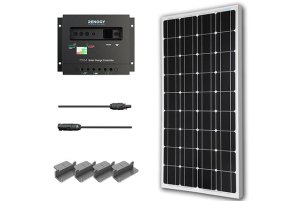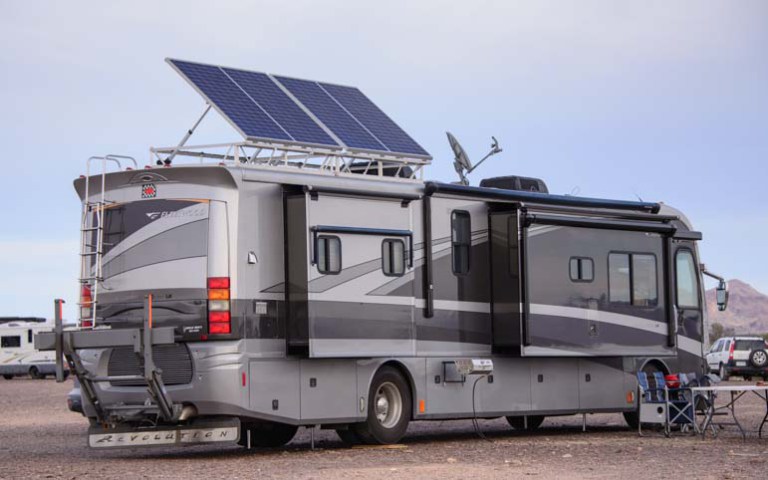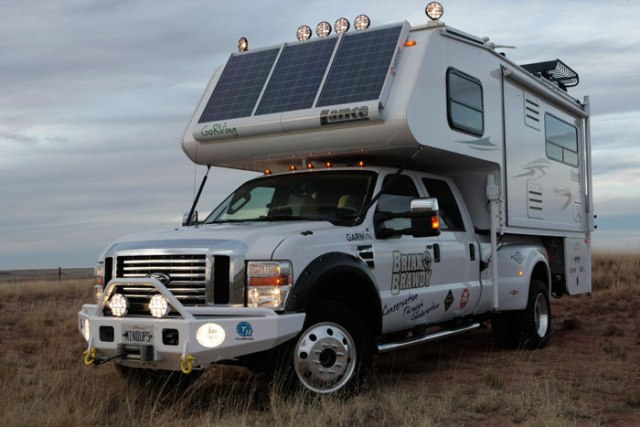What if you could design a completely independent motor home that uses solar power or grid power to charge batteries to provide engine power, a dehydration system for water and hydroponics for food? Do you think that would enhance your ability to be mobile and offset many bad effects resulting from the most common emergency scenarios you could conceivably be faced with? Dehydration systems and hydroponics are well-known so they are not discussed in this article. The purpose of this article is to describe how you can build your own solar-powered motor home.
Tesla and other electric vehicle sources are showing us how good the latest technology is in battery-powered vehicles. As you will see later in this article, Tesla’s latest powerhouse, the P90, offers over 700 horsepower and a range of nearly 300 miles using a battery that is small enough to hide in their car.
Design goals for the solar powered motorhome
- Range – this is determined by the battery pack. Goal is to maximize it.
- Power – I expect to replace the gas engine with about the same horsepower as it had.
- Recharge time – this is a challenge due to the limited space for solar panels.
Range
To understand the possibilities that exist one needs only to look at the latest Tesla P90. It has 762 HP and a range of 253 miles. So, In theory, if we just want 300 HP then using the same battery we should get a range of 642 miles, and at 60 MPH that should be over 10 hours! We know that this Tesla battery is small enough to hide in their luxury sedan body so with the amount of volume in a motor home our range is only limited by our pocketbook.
Powering your motorhome

Solar panels are coming down in price and can easily be mounted out of the way on top of your motorhome.
Research shows that many motor homes have gas engines that are rated at or about 300 horsepower . It turns out that a 3 phase 460 volt AC motor is readily available from many suppliers. An example is a simple search on EBay. RPM varies but 1800 RPM is quite common and, as you know, is nearly the same as the RPM of a gas engine at cruising speed. A valuable property of electric motors is that it is likely that the electric motor will have so much torque that the use of the motor home transmission might not be needed.
The next challenge is to cope with the power in amps needed to produce 300 horse power. Electric motors draw 750 watts per HP so the number of watts needed is ¾ times 300 or 225,000 watts. At 460 volts that will result in a current of almost exactly 490 amps. That current must be connected between the battery bank and the VFD by heavy copper bus bars. Bus bar tables on-line show that if one wants to limit the increase in the temperature of the bar to 30 degrees C (86 F) then a bar of copper that is 3/8 thick and 1 inch wide is recommended. One source for these is invisco.com/rv.

Solar Panel Starter Kit 400W
When replacing a gas engine with an electric motor it is necessary to replace the mounting hardware and the connection to the transmission shaft and the gas pedal. The frame used for 300 HP motors is technically termed a 449T and it is almost exactly 2 feet high and 2 feet long. The gas engine is larger than that and likely has 2 mounting points at the front of the engine and none at the rear because most vehicles depend on the transmission for the rear mount. It will be necessary to add a mounting brace to the front of the transmission and then add a platform for the motor. Invisco.com/rv is a source for this hardware.
Another detail is the speed control design. 3 phase speed controllers are easy to find. They are known as VFD or variable frequency drives and they are available from many sources. One source is vfds.com and another is EBay. The challenge is to adapt the speed control input signal to a gas pedal like pedal. One source for a speed control vehicle pedal is invisco.com/rv. Then there is the issue of solar panels. As you know, they are becoming easier to get. All of the electronics needed to wire them to a battery bank are available. The trick is to design the high power bus bars needed to power the inverter. Another challenge is to install enough batteries to run the huge motor for a time long enough to travel a useful distance.
Next is the time needed to charge the battery. Again, Tesla offers a glimpse into the future. If we rely only on solar power it will take some time. More on that later. Tesla gets a full charge in the P90 in just 1 hour and 15 minutes using 440 VAC! That makes a transcontinental motor home realizable. With New York about 2500 miles from Los Angeles, one could imagine traveling 642 miles at a time, stopping for a meal and a charge, then another 642 miles, etc.

Now, the reality of purely solar recharge is that a motor home is about 8 feet wide and 40 feet long and about 8 feet high. If we use just one side and the top for solar panels we get 640 square feet of panels. Best case if the panels were all facing the sun we would get 300 watts per panel. One panel is just about 18 square feet so we can get just over 35 panels on. That would get us 10,666 watts best case. In one hour we could expect 10.6 KWatts. We need 225 kilowatts and if we are going to use it for 10 hours we need 2250 kilowatt hours. So at 10.6 KW per hour we need to charge for about 225 hours. At 10 hours of charging per day in the summer that is less than a month. It is clear that using solar power alone for battery charging is the least efficient but it is possible.
Now a rough cut at the cost of this autonomous solar powered motorhome. First, a look at an average motorhome on the market today. A quick search for 40 foot motor homes shows there are many listed for sale at under $100,000 and some under $50,000. This is, of course, the major expense. The second largest expense is the solar panels at about $300 each or $10,500. Then the battery pack – I cannot find a good estimate on one but we know the Tesla P90 sells for about $90,000 so I imagine the pack might be $10,000. The AC motor is advertised on EBay for around $9000. Other miscellaneous parts might add up to $5000.

Combine solar power with rugged off-road capability for the best of both worlds.
In summary, here are the costs if we start with a $50,000 motor home
- $50,000 for motor home
- $10,500 for solar panels
- $10,000 for battery
- $9,000 for the motor
- $8,000 variable frequency drive
- $5,000 misc parts
- $92,400 Total
The single most important advance in technology that makes this all viable is the advance in battery design. Without the latest batteries made by Tesla and others we would be forced to install huge lead acid batteries and the whole design might be undesirable. For more information and to follow the progress on this project email [email protected]
source:theprepperjournal





